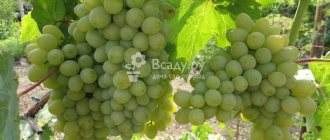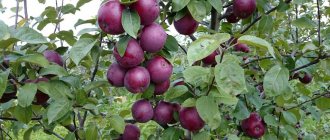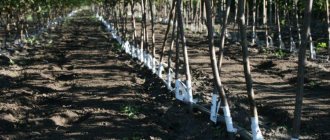Loading…
Loading…
At the summer cottages of gardeners in the middle zone, unpretentious frost-resistant varieties are often found. These include, for example, “Lydia” or “Isabella”. But, unfortunately, they are distinguished by small berries and inexpressive taste. Thanks to the efforts of breeders, species have appeared that produce large berries in the harsh climatic conditions of Russia.
By purchasing varietal specimens of modern selection, you can hope for a good harvest, resistance to disease and frost. By the way, the rich taste of a large beautiful bunch is not inferior to overseas products. Growing grapes in the middle zone for beginners is recommended to start with early varieties. They ripen in mid-August.
| From white to pink | From rich lilac to violet |
| Yantar Samara | Agat Donskoy |
| Muscat Tsikhmistrenko, dessert nutmeg | Kishmish unique |
| Delight | Brother of Delight |
| Northern early | Purple early |
The following varieties are considered no less popular: Kesha, Arcadia, Muromets and Cosmos. All of them are distinguished by large, fleshy berries, the size of a small plum. They have a delicate aroma, sweetness and excellent taste.
When should you buy planting material?
To purchase high-quality vines, use the advice of experienced winegrowers:
- Don't buy rashly. If you decide to buy a seedling from a nursery, do not take the first one you come across. Assess the situation, compare types, prices. It would be good if it was possible to examine adult specimens during fruiting.
- Consider purchasing cuttings from a large grape farm. Arrange a tour with the owner and ask about the variety of varieties. Try your favorite bunch. And then ask to sell cuttings from the selected grapes. This way you are guaranteed to get the right variety, and in addition valuable advice and guidance.
- Autumn material is usually more resilient than spring material. If it endures the winter cold, then in the spring it quickly grows.
- Beginners are not recommended to immediately take on complex and expensive hybrid specimens. They often require increased attention, a certain knowledge base and experience.
- Purchased seedlings should not be stored. It is recommended to soak them in clean water and plant them in the soil after a day.
Do not buy “elite” grape varieties at the market from intrusive sellers. Otherwise, you risk buying a “pig in a poke.”
How to choose healthy seedlings when purchasing
The choice of seedling is a very important point, since a successful purchase largely determines whether it will be possible to plant a good vineyard and whether it will be able to bring a decent harvest in the future.
You can make a purchase:
- in the nursery;
- in a large farm specializing in growing grapes;
- from breeders.
Did you know ? Currently, there are over 10 thousand varieties of grapes, and this is a record among cultivated plants.
Before purchasing, it is best for inexperienced gardeners to inspect the vineyard bush, see how it bears fruit, and find out about the peculiarities of its cultivation. It is better to opt for unpretentious varieties of autumn harvesting, since such cuttings are more hardy.
The choice of vine depends on many factors:
- First of all, you should carefully examine it. It must be properly trimmed, healthy looking, and without damage. It is better to make a purchase in nurseries, where planting material is prepared in accordance with the correct technology.
- The shoot from the cutting should be brown, which will confirm its mature state. The cut should be green, since a darker color will indicate the unsuitability of the planting material.
- If the seedling has leaves, their plate should have a smooth and clean appearance, without dents or bulges, which can be a sign of disease.
The quality of seedlings is determined by their variety:
- elite - have 4 or more roots, the thickness at the base is 2 mm, the length of the mature growth is 25 cm with a thickness at the base of more than 5 mm;
- the first - have several shoots, with one of them matured 20 cm or more. There are at least 4 roots and they are evenly spaced around the circumference; the thickness of half of them near the stem should be 2 mm or more;
- second - they have 3 growth nodes and two mature roots at the base of the trunk, but in all other respects they are inferior to the first grade;
- substandard - they are deprived of mature growths and are discarded or grown further.
Where is the best place to plant?
If you plan to plant one bush, then try to choose a sunny place for it. It should be away from trees and bushes.
For a future large grape farm, a place with the following characteristics is selected:
- slope on the south, southwest or east side;
- well-lit space during the day;
- a place remote from groundwater and wetlands.
Do not plant the vine on the north side, under a tree or near a pond.
How to plant?
- The material purchased and soaked for 24 hours is trimmed a little. The roots are shortened quite a bit, but the shoot is reduced by 3 buds. If there are side layers, they are also removed.
- The prepared seedling is dipped with its roots into a clay solution and placed in a prepared trench or hole.
- Consult with experts on what to feed the grapes during planting, at what depth to place the heel of the shank and which drainage is best suited for your area. Such advice will be better than general recommendations.
- If planting is done in winter, then you need to make a mound around the sprout, and when cold weather sets in, cover it with a plastic bottle. The top of the shelter can be covered with mulch or peat.
- Spring planting involves moistening the planting hole. After planting the chibouks and compacting the soil around them, they create shading. The bright spring sun can burn young shoots.
- A week later, the spring seedlings are watered again, and after the soil dries, its top layer is loosened.
Grape planting methods
To plant a crop, you can use several methods, which differ in the preparation of the material and place for the vineyard.
Use of seedlings
In the fall, a pit is prepared according to the above recommendations and seedlings are harvested. The cuttings should be cut under the lower bud. The upper cut is made horizontally at a distance of 3-4 cm above the kidney. For better rooting, cuttings are soaked in stimulating preparations - “Konevin”, “Epine” and others. Then place it in a glass container with water until the first roots appear. An important rule is that the prepared seedling is kept in a seedling container in a warm place, ensuring regular watering until planting in a permanent place in the spring.
Planting grape seedlings in the spring in the middle zone is carried out in May-June. The cuttings, prepared in the fall and rooted, are planted after the formation of a stable temperature regime of at least +16 degrees. After planting, the seedling is watered with 2 buckets of warm water, and the soil surface is mulched with sawdust, sand or dry soil.
In the garden
This method is suitable for growing grapes in the northern territory. To cultivate in open ground, certain steps must be followed:
- For planting, a trench is prepared 10 m long, 30 cm deep and 1 m wide.
- The soil is prepared in the standard way.
- The ditch is filled with nutrient substrate, keeping the height of the bed 35 cm above the soil level.
- First-year grapes are planted, deepening by 45 cm.
Watering and fertilizing are carried out through a piece of pipe dug into a trench.
Planting in a greenhouse
Planting grapes in the middle zone can be done in a greenhouse. This method will allow you to harvest earlier. Preparing the soil, as well as pruning and preparing the cuttings, are carried out according to the standard scheme. When planting annuals, maintain a distance of 15-20 cm. Moisturize and fertilize young plants once a week.
Grape planting scheme
In order to properly plant grapes in central Russia in the spring, you must adhere to the recommended scheme for planting seedlings. The culture reacts painfully to transplantation, so the plant is planted in a permanent place of growth the first time. The distance between seedlings depends directly on the length of the vine:
- For a lash with a length of 2.5 m, a gap of 3 m is required.
- For a vine not exceeding 1.5 m - 2 m.
- For a seedling with one vine – 1.5 m.
The row spacing should be 2-2.5 m wide. Other crops can be placed in this area. The optimal neighbors for grapes will be greens and strawberry bushes.
How to care for a vineyard in spring?
After the growth of young specimens, as well as one-year and two-year-old seedlings, require a number of mandatory procedures.
Caring for grapes in spring is as follows:
- removing weeds under the vine and around the bush;
- loosening the top layer of soil;
- annual pruning of weak roots at a depth of 20 cm underground (the soil is raked and the grapes are pruned);
- spring preventive spraying of plants with Bordeaux mixture before the beginning of the growing season.
How to water correctly?
To ensure sufficient nutrition for adult plants, it is necessary to water abundantly several times during the spring and summer season. At a time - at least 15 liters of water for 1 bush. Water in the roots should not stagnate. Otherwise, fungal diseases and rotting of the root system may occur. Properly organized drainage will help avoid this. To understand how often to water grapes in summer, you need to know the temperature regime of the region in summer. In cold and rainy summers, you can flood the bushes 2 times. If the temperature indicators are normal, then 4 watering seasons can be carried out.
If the weather is too wet, then the grapes should be given special attention. Special treatment of grapes after rain is required. High humidity provokes the immediate spread of harmful spores. It is necessary to spray the bushes with multi-purpose solutions that can protect against late blight, mildew and oidium.
Choosing a suitable landing site
Considering the recommendations above, choose the sunniest and warmest place on your site. It is strictly not recommended to plant grapes mixed with any trees, because this is a light-loving plant. Of course, the bushes will grow, and even strongly, but you won’t get a harvest until the tops of the vines grow higher than the tree crowns.
Grapes can grow on almost any soil, because it can be easily cultivated and improved with the help of special agricultural technology.
Soil requirements and preparation for planting
The grape easily adapts to the environment; in addition, the plant is not demanding and tolerates any type of substrate. Therefore, any bright place in the garden is suitable for it. It grows well in well-drained sandy soil that warms quickly in the spring.
The soil can be acidic, neutral and alkaline. A pH level of 7 is neutral, above 7 is alkaline, below 7 is acidic. The most favorable soil for planting grapes is considered to be the soil with a pH level from 5 to 7. If necessary, all these indicators can be adjusted by adding fertilizers, minerals, lime and other additives. Heavily calcareous soil requires the use of grafted seedlings to eliminate the risk of chlorosis.
The soil for planting grape seedlings with a pH level of 6.5 to 8 should not be too moist or salty. With high humidity, drainage is required, since the soil must be loose. Sandy soil with good aeration is most suitable for planting grapes. High acidity is reduced by adding lime at the rate of 200 grams per 1 square meter. m. On it, the grapes ripen faster, and the berries and clusters grow large and sweet.
Preparing the planting hole
Before planting grape seedlings, it is necessary to determine the pH level of the soil and its type by conducting an appropriate examination. If the moisture level is high, it is necessary to add fragments of broken brick, crushed stone or expanded clay to the bottom of the planting hole. Cover the top of the hole with earth mixed with river sand. The bottom is filled with superphosphates, peat, humus, compost mixed with soil.
The main tillage is deep plowing to a depth of 50-60 cm at least a month before planting the grapes. This is necessary so that the root system of the grapes receives the required amount of oxygen and nutrients from the soil. Then it is necessary to apply potassium and phosphorus fertilizers and scatter cow manure (10 kg per 1 m2). In one or two months it will be possible to begin planting grape seedlings.
What is pruning and when to do it?
Middle zone winegrowers carry out global pruning twice a year. Pruning grapes in the fall is necessary before sheltering for the winter. Long shoots are shortened, after which it is convenient to place them in a recess and cover them. The spring procedure occurs after opening. Frozen and dry shoots are removed. In addition, during the growth of the bush, shoots are pinched and trimmed to ensure proper formation of the vine.
In order for the bush to be properly formed, it must be pruned from the first year. Green shoots are broken off, preventing them from braiding branches. On young specimens, flowering branches are removed, preventing the berries from developing. First-year plants can become exhausted, devoting all their energy to growing the bunches. The remaining shoots are directed and tied up.
If you expect to get a powerful plant, then it is better to direct all the remaining sprouts upward.
The correct formation of a grape bush from the first year is shown in the video, which will help you understand the basic principles of the procedure and prevent mistakes.
What is the difference between the middle band
Everyone knows that grapes are a heat-loving crop; most often they can be found in the south of the country. The main conditions for comfortable plant growth are warmth, plenty of sun, moisture and fertile soil. For successful cultivation in central Russia, timely pruning of leaves and branches is a prerequisite.
The climate in the regions located in the central zone of the country is temperate continental, which provides heat in summer and moderate frost in winter. The flat terrain favors the reign of winds that bring cold. For this reason, grapes did not grow here for many years. Today, with proper care, this plant is planted in summer cottages.
Grapes in summer cottages
The culture requires that there be a lot of humus in the soil, since a large and powerful bush grows, which is capable of climbing the wall of a multi-story building with its branches or completely covering a gazebo.
But in central Russia it is difficult to create such conditions for plants. Before planting grape seedlings, you need to do a soil analysis and determine how much humus it contains. In addition, you need to find out how quickly soil mineralization occurs and whether the plant can develop under these conditions.
Humus is the organic remains of other plants. They become food for the grapes. But if the bush still does not grow, then you need to pay attention to the acidity and alkalinity of the soil.
If the acidity level is increased, then the soil is treated with lime
In the regions of the middle zone, when growing grapes, it is very important to carry out mulching. This process will be the key to a good harvest. Because cold winds and rains, together with loosening the soil, do not create comfortable growing conditions, but, on the contrary, dry out the soil and wash out all the minerals useful for grapes. Therefore, the application of fertilizers is only welcome here.
How to cover grapes for the winter?
All hybrid varieties require a warm winter. Therefore, in the fall, before the onset of frost, it is necessary to dig down all the shoots or cover them with covering material. This will keep the plant from freezing. After autumn pruning, the bush is well watered. Then all the vines are removed from the trellises (do-it-yourself trellis for grapes) and laid on straw or dry leaves. The top is covered with spruce branches, a wooden structure, or simply covered with a layer of earth.
If you don’t know how to cover grapes for the winter, you should watch the video and prepare in advance. You cannot refuse to carry out this procedure, otherwise you will not be able to grow a healthy plant.











